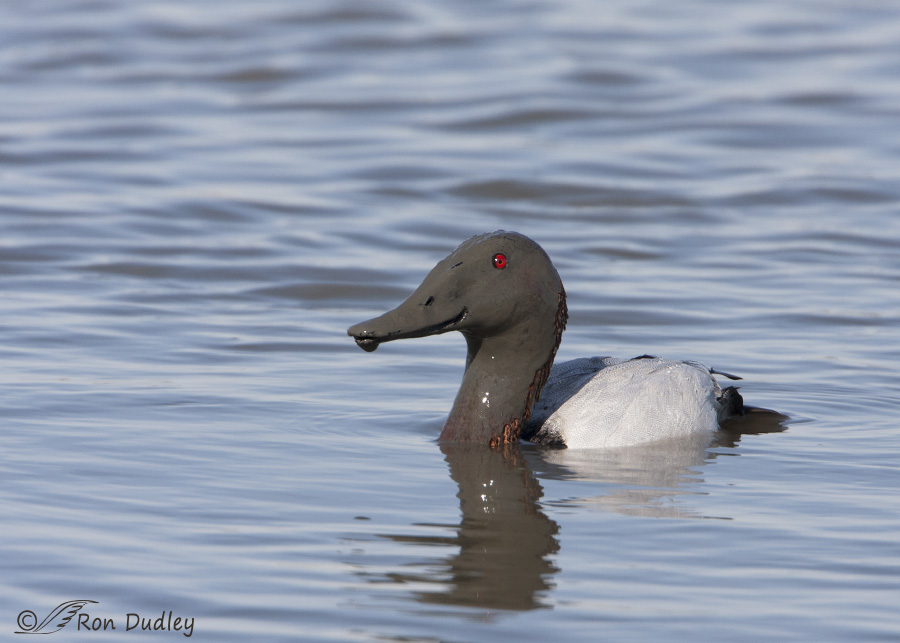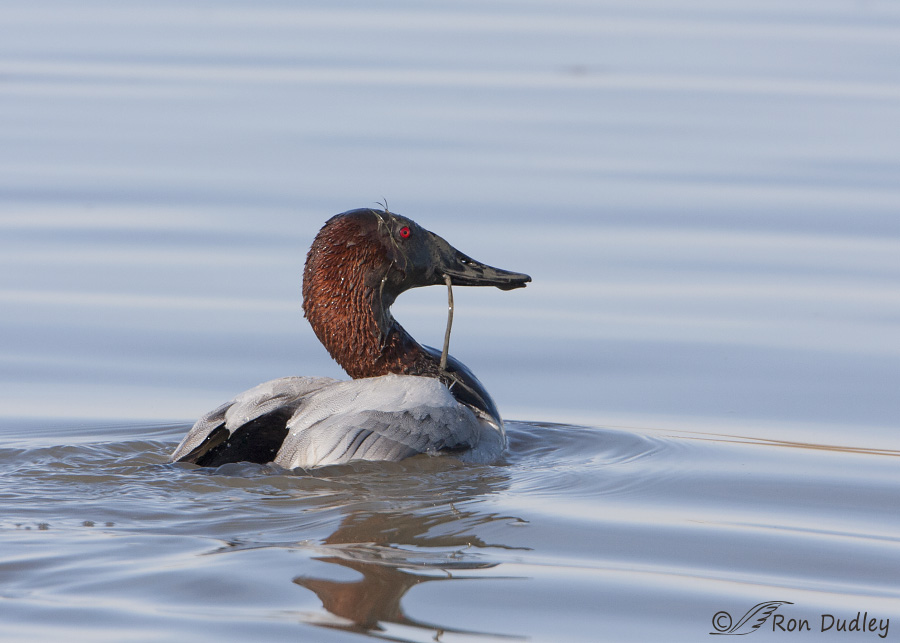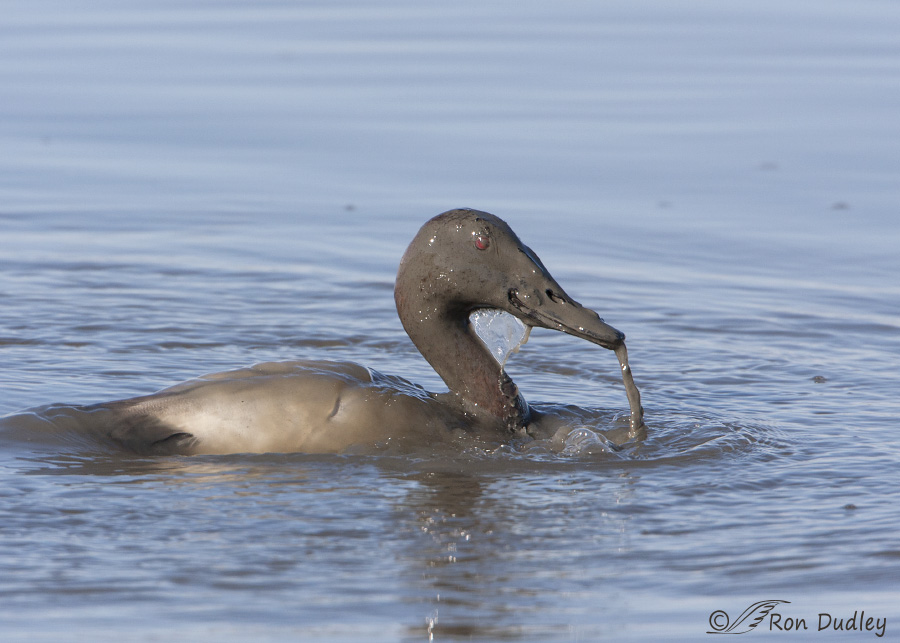I worked harder at getting this (third) shot than any other single image. Ever! It’s ugly but I love it.
But first some background. Back in April of 2008 I was still a novice bird photographer. I hadn’t had my new 500mm lens for long and I was determined to learn how to use it better and improve my overall photographic skills. So when I had a rare opportunity to photograph feeding Canvasbacks up close near Farmington Bay WMA I worked very hard at getting the most interesting, high quality images I could.

1/1600, f/8, ISO 400, Canon 40D, Canon EF 500mm f/4L IS USM + 1.4 tc, not baited, set up or called in
The pond was shallow and the Canvasbacks were feeding in the mud at the bottom (by diving, not feeding from the surface) so when they came back up their heads and necks were covered in a layer of thick mud, to the point that there usually wasn’t anything in those areas that was bare of mud except their blinking red eyes. In this image the only place where we can see the normal red color of the head and neck is a small area near the surface of the water.
Canvasbacks are known as “the aristocrats of ducks” but these feeding birds were looking far from aristocratic. I spent almost as much time laughing as I did taking photos.

1/1600, f/8, ISO 400, Canon 40D, Canon EF 500mm f/4L IS USM + 1.4 tc, not baited, set up or called in
Usually these ducks were straining water out of the mud and food in their bills while they were still underwater but occasionally I would see it still happening just after they popped up to the surface. Here we see a stream of muddy water being forced out of the right side of his bill but often the water would come out both sides or even the front of the bill.
At this point I made the decision that come hell or high water I was going to get a shot of one of the ducks just at the moment it popped to the surface. I had very specific goals for that shot in mind;
- the bird would still have muddy water streaming off its back and elsewhere
- strained water would still be coming out of its bill
- it would have to be a profile view to show the muddy head and everything else I was after – no butt shots!
- it had to be up close and sharp
This was a very tall order and what made it most difficult was the fact that I never knew where these birds would pop up to the surface. Typically I had about a second to focus on the bird after it emerged before the water was no longer streaming off its back and coming out of its bill.
Time and time again I was too late. Or the bird was soft. Or I got a butt shot. Or there was no water coming out of the bill. Or there was a damned coot in the background. The list was endless.
But my stubborn streak kicked in and I worked at it for almost two hours. I succeeded only one time.

1/1600, f/8, ISO 400, Canon 40D, Canon EF 500mm f/4L IS USM + 1.4 tc, not baited, set up or called in
This is that shot. I caught the bird just at the moment it popped to the surface, there’s still water coming off his back, there’s thick muddy water coming out the tip of his bill, I caught him in profile and the bird is sharp. There’s even the bonus of that web of streaming water where the head meets the neck in the “chin” area.
It certainly isn’t a pretty image and there’s annoying specular highlights on the muddy head but I was still absolutely delighted to have finally succeeded. Looking back I believe this to be one of those pivotal photographic moments for me for two reasons: I was beginning to see that good bird photography isn’t easy so among other things it takes a lot of real work. And this experience was one of two or three that really ignited my passion for photographing bird behaviors. Regular readers know that I still have that passion (addiction…?).
I’ve posted this final image before, long ago, but I’ve never really told this back story so I thought it deserved another look. Besides, we’re in the midst of a slow-moving winter storm so who knows when I’ll be able to go out shooting again and present new images…
Ron


Fun! I really do love these retro posts because it is fun to see where you were and WHY you are still doing this.
Somehow I missed this…oh yeah, I was off to Ithaca to hunt the hawks! So it really is useful to filter through an 800-email notification backlog. LOL!
LOVE these shots! What a muddy duck(ling)! And just goes to prove that sometimes, that majestic thing just isn’t practical. Nor does it always work for you. Life gets messy sometimes.
There are so many things I love about your blog, Ron. What stands out this morning is your sheer persistence and how wonderfully it pays off for all of us hanging out here in the peanut gallery. Rugged persistence/stubbornness almost always reaps amazing rewards. Quitting does not. Thank you SO much for being a stubborn curmudgeon in the context of illustrating that point. Just love meeting up with you and your photography every morning! You ROCK!
You also make me wish I could have captured some of the wondrous images etched in my memory while hunting with the hawks. I’ve seen such amazing things with them. Alas, I couldn’t.
I laughed out loud at these pics. I too enjoy ducks but the mud and water squirting out was a fine catch!!
Still Laughing. I have to go back repeatedly and look at the first photo.
Actually mud masks are very helpful. At least he was still smiling!
Mud packs rule. Though I am never tempted to eat through mine…
Yet another stunning shot, and the back story makes it even better.
Mind you, I am as usual agreeing with Patty. I too like the shots that you don’t.
“Mud packs rule. Though I am never tempted to eat through mine”
Once again you made me laugh out loud, EC. How do you DO that?
Man, they had to be really hungry or the food was fantastic or plentiful for them to endure the mud!
Absolutely great shots. Appreciate the storyline, the anxiety and trouble you had to go through, between the frustration and laughter!
Apparently they were REALLY hungry, Dick. They were feeding steadily for hours.
Thank you for sharing your learning experiences! I am still trying to get very sharp bird images, but thus far it is more luck than knowledge! As usual, your pictures are great. I can’r recall ever seeing a Canvasback. That will be on my list.
Jane, When they don’t have muddy heads I’m of the opinion that male Canvasbacks are the most handsome of all the North American ducks (and yes, that includes Wood Ducks). I hope you get to see one (or more) some day.
Sweet. Thanks for the backstories…they make the photos even more rich!
I’m glad you enjoyed both, Susan. Thank you.
Dear Ron,
I do wildlife art and am very impressed with your photography—do you ever give permission to paint from your photos? If you give me an email address I can send some examples of my work. I have work with a nature photographer Per Gunnar-Ostby in the past.
Sincerely,
Bobbi
Thank you, Bobbi. I always require a reasonable licensing fee when any work using my images is displayed publicly – including on the internet.
What amount do you usually charge? The most exposure my work would probably get would be in an Art exhibition or our local fair.
Bobbi, I’ll reply via email.
Hi Ron, As a former hunter the “Can” has always been my favorite duck. It is the best eating and most fun hunting.
I haven’t shot one, except with a camera, for 40 years but your pictures brought back wonderful memories.
Len, As a teenager growing up in Montana I used to occasionally hunt ducks too but I don’t remember even seeing Canvasbacks back then.
I actually like the first shot with the clear ruby-colored eye better than your final pic, but both illustrate the behavior better than any other shots I’ve seen. Fantastic work.
Thanks, Brian. I agree that aesthetically the first image is more appealing but when I factor in degree of difficulty, if I had to choose one shot over the other, I’d take the last one in a heartbeat.
The last time I saw a mudhead it was dancing in Hopi Land–no water in sight….
Great post, Ron. I had a nice laugh when I read, “Time and time again I was too late. Or the bird was soft. Or I got a butt shot. Or there was no water coming out of the bill. Or there was a damned coot in the background. The list was endless.” That describes bird photography in a nutshell pretty well. We’re all glad for your passion, which keeps us coming back. And your right in that they aren’t pretty, but they’re great behavioral shots. Sure hope that storm moves on so you can get out soon.
“That describes bird photography in a nutshell pretty well”
Boy, that’s for sure, Dave! But as I often say, “if bird photography was easy everyone could do it well”.
I’m glad you enjoyed my description of the frustrations. Looking back I do too but I sure didn’t enjoy those frustrations at the time!
These shots show how important the red (on head and neck) plays in the handsomeness of these beautiful ducks…the mud turns them into “ugly” ducklings….but wearing a “mud pack” is an old beauty treatment, so maybe it’s why they are usually so handsome!
Glad you accomplished so many of your goals with these shots…when you’re happy, I’m happy…..(and, must admit, when you’re NOT happy with one of your shots, I’m still happy!)…,,,
Cool! No one would guess the work that went into capturing the picture if you hadn’t told us! “Lucky” would be the call – ha! Glad you rose to the challenge and are sharing it all with us!
Thanks, Judy. The harder I work the “luckier” I get!
What are “specular” highlights? I knew water fowl ate nutrient-rich mud, especially in the winter, but am surprised to see that these canvasbacks went so deeply into it…so deeply that its entire head would be encased in the stuff. Also surprised that it didn’t wash off as they lifted their heads from the water….another interesting blog!!! They just keep coming….amazing! Something new every day…no wonder I’m addicted….
Thank you, Patty. Specular highlights are bright spots of light that appear on shiny objects when illuminated. Here they appear as specks of blown whites on the shiny mud on the head and neck especially.
The mud was so thick that it didn’t wash off quickly or easily in the water. The ducks would have to shake their heads to get rid of it but then they just got it back on their next dive.
One more thing – they didn’t just “lift their heads from the water”. They dived down to feed in the mud so that their entire bodies disappeared from view. That’s what made it so difficult to predict where they’d come back up…